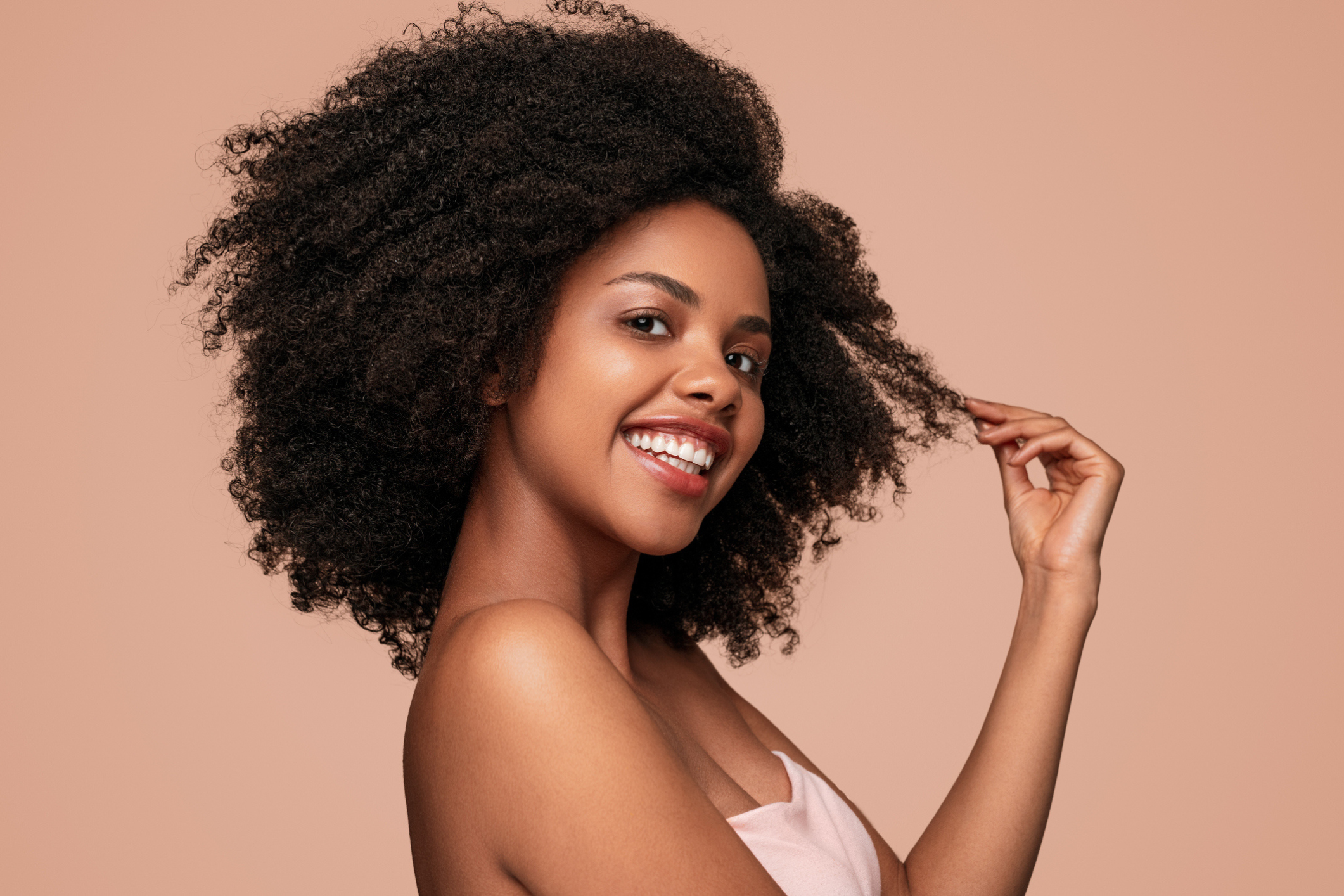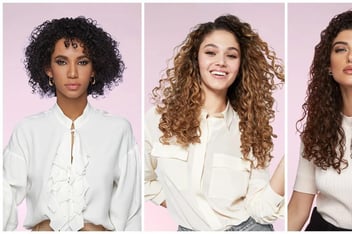 5min
5min
Looking for curly hair styling tips? You’ll need to know your curl type first.
Saying that all curl types are the same is like saying there’s only one type of jeans – when really it's a vast spectrum. Just like your trusty denim can span light wash to dark wash, and come in fits from skinny to wide-leg, curls can range from waves through to tightly wound coils – with everything from ringlets to corkscrew curls in between. Understanding your curl type, and what it wants and needs, will allow you to tailor your routine to make the most of your hair’s natural beauty. Read on for curly hair styling tips aplenty, product recommendations and drying techniques unique to your kind of spirals…
Styling tips for each curl type
To make it easy to decode which curl type you have, the experts have divided them into nine categories using a numbered and lettered code.
The number indicates the type of curl, while the letter reflects their diameter. Getting to know your curl type will make styling easier, and we’ve broken down the best techniques and curly hair styling tips for each….
How to style type 2 curls
Type 2 hair is categorised as wavy with a bendy shape. It’s the closest relative of straight hair, with a shape that allows the cuticles that coat your hair strands to slot neatly together. This makes it less prone to things like damage and frizz - and therefore more manageable than other curl types.
-
Type 2A: This curl type is straight at the root and wavy through the lengths. It needs persuasion to take on movement, so focus on creating volume at the crown and throughout when washing and styling. You can achieve this by scrunching the hair when it’s wet to encourage bounce from the get-go, using mousse to add oomph and diffusing upside down for added spring.
-
Type 2B: Type 2B hair has a bendier and more consistent wave than 2A, and the best way to style it is to play up its natural beachiness. Replicate the seaside with a salt spray for texture and grip. Move your head from side to side when drying to mimic a beachy breeze and use the nodules to create the definition and movement you’d get from running your fingers through your hair when you get out the water.
-
Type 2C: Type 2C hair is the curliest of the wave family with a wide ‘S’ shape but it’s still bendy as opposed to spiral. Use a hair gel through your lengths to add definition to the pattern. For consistently shaped curls with plenty of bounce, try pixie diffusing. The technique involves turning your head upside down and gathering sections of hair into the diffuser before drawing it towards your scalp. Hold until dry and move on to the next section.
How to style type 3 curls
Type 3 hair is what you picture when you think of curly hair. It has a defined ‘S’ shape which is beautiful to look at but unfortunately, prone to dryness as the cuticles aren’t able to slot together as neatly and breakage as it can snap on the bends.
-
Type 3A: These are the kind of big, bouncy curls that people recreate with a salon blow-dry – how lucky are you to have them naturally? To maintain their volume and prevent them from dropping, shape your curls when they’re wet by spiralling around your fingers. The tighter you make them, the curlier they’ll stay between washes. Apply curl cream to nourish and boost shine, and always dry with the diffuser pointing upwards to maintain spring.
-
Type 3B: Type 3B curls are your classic ringlets. Due to their shape, the hair can be quite dense, making drying a long process. Start by plopping (wrapping the hair in a microfibre towel) to absorb excess moisture and then diffuse from the roots down, sectioning hair with gentle clips if needed. Adding a smidge of leave-in conditioner is key to maintaining softness in this curl type.
-
Type 3C: The narrowest of the type 3 curl family, 3C curls are moving into coily territory but (just about) maintaining that ‘S’ shape. They don’t need any help with volume, so instead concentrate on preserving their pattern and minimising damage. Swap conditioner for regular hair masks to hydrate and nourish, and avoid protein-packed formulas that can make your strands brittle. When diffusing, hold your tool side-on to dry without making your curls bouncier or flatter.
Identifying your exact curl type is the first step to finding the perfect hair care routine for you! Read our guide "Discovering curl types and hair styles".
How to style type 4 curls
Type 4 hair is also known as coily or afro hair. Instead of an ‘S’ shape it has a ‘Z’ shape with more exaggerated bends. The sharpness of these angles makes it fragile and also prevents the natural oils from your scalp from travelling down the hair shaft. On the plus side, that means you don’t need to wash your hair as often, but you do need to use extra products to maintain its moisture levels and style with care.
-
Type 4A: 4A hair is a blend of both ‘S’ and ‘Z’ shapes, and massaging the finger-like nodules of your diffuser into your curls will amplify these. To avoid missing any spots, dry in sections starting from the roots where the hair is newest and least porous before moving onto the ends. Heat protection spray is a must-have for healthy hair, while curl butter will hydrate and define your hair at in one swoop.
-
Type 4B: With a zig-zag shape and plenty of volume, type 4B hair is widely coveted. To preserve its pattern and avoid snagging, only ever comb or brush when the hair is wet, and use soft, wide-tooth tools. Hover diffusing, where you hold the diffuser around 15cm away from the hair instead of directly onto it, is a great technique for this curl type to speed up drying time without causing breakage. Finish with a slick of gel or wax for extra definition and to smooth flyaway hairs around your edges and hairline.
-
Type 4C: Type 4C coils are so tightly wound that you can’t see any separation between them. This curl type is prone to shrinkage, where the hair looks shorter after drying, and although this is a sign of hair health and elasticity, it’s not to everyone’s tastes. If you prefer longer-looking hair then use the stretch diffusing technique to elongate by drawing the diffuser down through the hair. Applying oil to your lengths will keep hair soft and nourished between shampoos.
Why is it so important to dry curly hair properly?
Spending lots of money on fancy products and an hour painstakingly twisting sections of hair around your fingers is a big old waste of time and money if you’re not finishing your routine by drying your curls properly. Diffusing your hair using the right techniques is important to:
Maintain definition
Standard hairdryers made for straight hair have more power than diffuser tools made for curly hair, blowing your strands with gale-force speeds that leave you with a cloud-like mass rather than defined curls. The nodules on a diffuser head will work in tandem with lower wattage and slower speeds to maintain definition.
Stop your curls from falling flat
Drying your hair with high speeds, tying it up and sleeping on one side will all knock the volume out of your curls and cause them to drop. The beauty of a diffuser is that it can be used at different angles (including upside down) to enhance volume and bounce.
Keep damage to a minimum
There are a few ways to dry curly hair to avoid damage. You can air dry, leaving your curls entirely to their own devices, speed things up by plopping or use a dedicated diffuser tool that works at slow and low settings. All of these will stop your strands from being exposed to unnecessarily high temperatures, keeping damage to a minimum. Damaged hair is crispy, dry and dotted with split ends, while healthy hair is much more manageable.
Avoid frizz
Our hair strands are coated with cuticles designed to seal in moisture, but the shape of curly hair stops them from overlapping, leaving gaps that hydration can escape through. Overheating your hair only makes matters worse, causing bigger gaps in the cuticles that lead to dryness and frizz. Gently drying your hair will keep fluffiness at bay.
Make your style last
Diffusing is great for maxing out time between washes as you use the built-in nodules to style your hair instead of your fingers which stops you from transferring oil and grease from your hands onto your strands.
If your tool has the option for a cool shot, even better. The change in temperature from warm to cold will make your hair cuticles lie flat, sealing in moisture and setting your style in place.
Embrace the individuality of your curls with Bellissima Italia
Everyone’s curls are different, and that’s what makes it such a beautiful hair type to have. While there isn’t a one-size-fits-all technique for curly hair styling tips, there is a tool that works for all.
The Diffon Supreme has been designed to enhance all curl types, with features like a gentle power system, digital heat control and ion care technology to dry the hair respectfully.
Adjustable heat and speed settings combined with the ergonomic shape that can be held in different ways make it easy to tailor the tool to exactly what your curl type needs.






